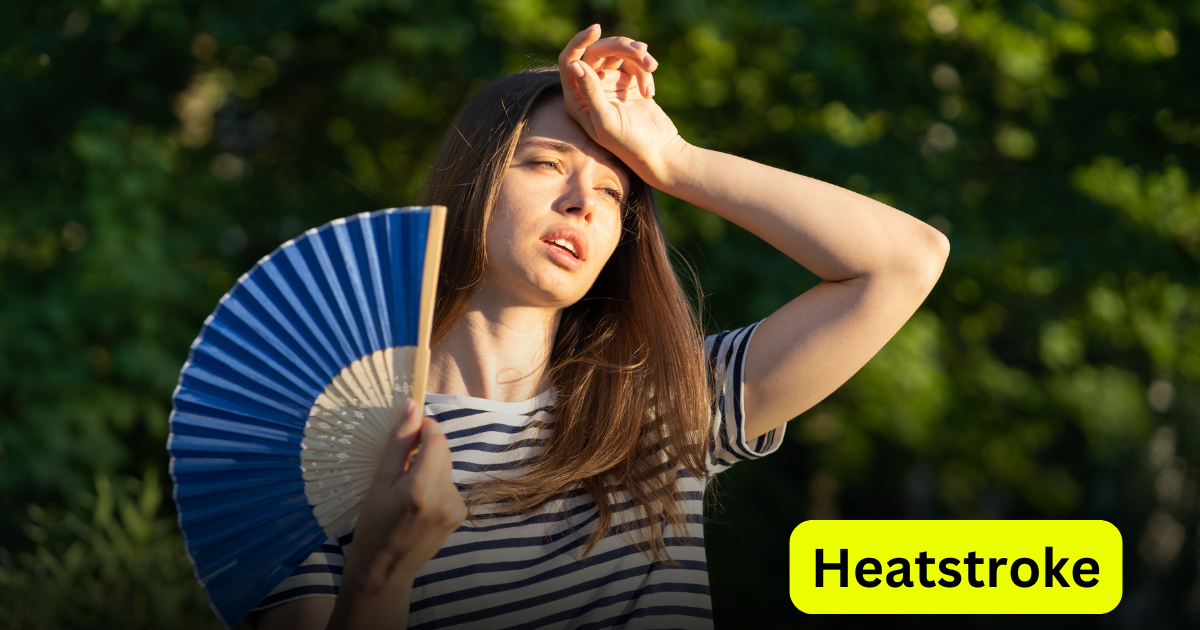Heatstroke, also known as hyperthermia or sunstroke, is a severe heat-related illness that occurs when the body overheats and cannot regulate its core temperature. The condition is life-threatening and can result in long-term complications or even death if not treated promptly. Understanding sun-stroke’s causes, symptoms, treatment, and prevention strategies can significantly reduce the risks, especially during high-temperature conditions.
This article will explore everything you need to know about heatstroke, including how to manage it and tips on preventing this dangerous condition.
What is Heatstroke?

Heatstroke occurs when the body’s temperature rises above 104°F (40°C) due to prolonged exposure to high temperatures or vigorous physical activity in a hot environment. It can occur quickly without warning and is a medical emergency. The body’s cooling mechanisms, such as sweating, fail, leading to an uncontrolled rise in body temperature. If untreated, heatstroke can cause damage to vital organs such as the brain, heart, kidneys, and muscles.
There are two types of heatstroke:
- Exertional Heatstroke (EHS): Usually affects younger, active individuals and is triggered by physical exertion in hot weather.
- Non-exertional (classic) sun-stroke: This type is more common among older adults and those with chronic health issues, developing after prolonged exposure to hot environments.
Causes of Heatstroke
Heatstroke can be caused by various factors:
- High Temperatures: Extended exposure to high temperatures, especially when combined with humidity, makes the body lose its ability to cool down. Common during heat waves, this is a significant cause of non-exertional heatstroke.
- Strenuous Activity: Vigorous physical activities, such as exercising or working in hot weather, often result in exertional sun-stroke, especially if the individual is not used to the heat.
- Dehydration: Inadequate fluid intake can impair the body’s ability to sweat and maintain a healthy core temperature.
- Wearing Heavy Clothing: Clothing that restricts airflow and prevents sweating can raise body temperature, leading to sun-stroke.
- Alcohol Consumption: Drinking alcohol affects your body’s ability to regulate temperature, increasing the risk of heatstroke.
- Pre-existing Health Conditions: Heart disease, obesity, and other chronic illnesses increase the likelihood of developing heatstroke(Mayo Clinic)(Cleveland Clinic)(Allina Health).
Symptoms of Heatstroke
Heatstroke symptoms often appear suddenly and require immediate medical intervention. Recognizing these symptoms in time is crucial to prevent irreversible damage. The symptoms include:
- High Body Temperature: A core body temperature of 104°F (40°C) or higher.
- Dry or Sweaty Skin: In exertional heatstroke, excessive sweating may occur, but in non-exertional cases, skin may become dry and hot.
- Altered Mental State: Confusion, agitation, slurred speech, irritability, seizures, or loss of consciousness.
- Rapid Heart Rate: The heart struggles to cool the body, leading to a fast pulse.
- Throbbing Headache: Persistent, severe headaches are a key sign.
- Nausea and Vomiting: The body’s inability to regulate itself often leads to digestive discomfort.
- Dizziness or Fainting: Lightheadedness or passing out due to dehydration and overheating(Mayo Clinic)(Cleveland Clinic).
If these symptoms arise, it’s critical to seek emergency medical help immediately. sun-stroke can cause severe organ damage and death without prompt treatment.
Risk Factors for Heatstroke
Certain factors increase the likelihood of sun-stroke. These include:
- Age: Infants, children, and elderly adults are particularly vulnerable due to their weaker ability to regulate body temperature.
- Physical Exertion in Hot Weather: Activities such as sports, military training, or manual labor in hot conditions raise the risk of sun-stroke.
- Sudden Temperature Exposure: Individuals exposed to sudden changes in weather, such as tourists or people moving to warmer climates, are at higher risk.
- Lack of Air Conditioning: Prolonged exposure to hot, unventilated environments increases susceptibility to heatstroke.
- Chronic Illnesses: Pre-existing conditions like heart disease, lung disease, and obesity elevate heatstroke risks.
- Medications: Diuretics, beta-blockers, and antidepressants can impact how your body handles heat(Mayo Clinic)(Cleveland Clinic)(Allina Health).
Complications from Heatstroke
If left untreated, heatstroke can result in serious complications:
- Organ Failure: The liver, kidneys, and other organs may fail due to the body’s overheating.
- Brain Damage: Sun-stroke can cause swelling in the brain, leading to permanent damage.
- Shock or Coma: A prolonged sun-stroke episode can result in loss of consciousness or even death.
- Acute Respiratory Distress Syndrome (ARDS): This occurs when fluid accumulates in the lungs, hampering breathing(Mayo Clinic)(Cleveland Clinic).
Treatment for Heatstroke
Immediate action is critical when treating sun-stroke. Here’s how you can help if you suspect someone is suffering from sun-stroke:
First Aid Measures
- Move to a Cooler Area: Help the affected individual to a shaded or air-conditioned space.
- Apply Cool Compresses: Place ice packs on the neck, armpits, and groin, or douse the person with cold water.
- Fan and Mist: Use a fan and mist water to create evaporative cooling.
- Offer Hydration: If the person is conscious, offer cool water (not ice-cold) or sports drinks to restore hydration. Avoid alcohol and sugary drinks.
Medical Treatment
Once in the hospital, doctors may use:
- IV Fluids: Cooled fluids are administered intravenously to rapidly lower the body’s temperature.
- Cooling Blankets or Ice Baths: These methods help bring the core temperature down to a safe level.
- Medications: Seizure-preventing drugs may be necessary if the patient’s symptoms include neurological distress(Cleveland Clinic)(Allina Health).
How to Prevent Heatstroke
Sun-stroke is preventable with the right precautions. Consider these preventive tips to protect yourself and others during hot weather:
Stay Hydrated
Drink plenty of water throughout the day, especially during heatwaves or periods of intense physical activity. Avoid alcohol and caffeine, as they dehydrate the body.
Avoid Direct Sunlight
Limit your exposure to direct sunlight during the hottest parts of the day, typically from 10 AM to 4 PM. If you must be outdoors, stay in the shade as much as possible.
Dress Appropriately
Wear loose-fitting, lightweight, and light-colored clothing to allow for air circulation and minimize heat absorption. A wide-brimmed hat and sunglasses also help protect against sunburn, which can exacerbate heat-related illnesses.
Gradual Acclimatization
If you’re not used to high temperatures, gradually increase your exposure over several days or weeks to allow your body to adapt to the heat.
Use Air Conditioning
Air conditioning is one of the most effective ways to cool down during hot weather. Spend time in air-conditioned spaces when possible. If your home lacks air conditioning, consider visiting public places such as malls or libraries during extreme heat.
Monitor Weather Conditions
Check the heat index regularly and avoid strenuous activities on especially hot and humid days.
Never Leave Children or Pets in Hot Vehicles
A car’s internal temperature can rise rapidly, making it extremely dangerous to leave children or pets inside, even for short periods(Mayo Clinic)(Allina Health).
Conclusion
Heatstroke is a preventable but serious condition that requires immediate medical attention. By understanding its causes, symptoms, and preventive measures, you can significantly reduce your risk of experiencing this life-threatening illness. Stay vigilant during heatwaves, stay hydrated, and take precautions when spending time
Read More
10 Hidden Facts About Carnivore Diet Snacks
Frequently Asked Questions (FAQ)
1. What are the early signs ofsun-stroke? Early signs include a high body temperature, rapid pulse, headache, dizziness, nausea, confusion, and dry skin that may or may not sweat.
2. How long does it take to recover from sun-stroke? Recovery depends on the severity of the sun-stroke. Mild cases may take a few days, while severe cases may take weeks or even lead to long-term complications.
3. Who is most at risk of sun-stroke? The elderly, infants, people with chronic illnesses, and those involved in strenuous physical activities in hot environments are most at risk.
4. Can sun-stroke cause permanent damage? Yes, heatstroke can result in permanent damage to the brain, heart, kidneys, and muscles, particularly if not treated promptly.
5. What should you do if you suspect someone has sun-stroke? Call emergency services immediately. While waiting for help, move the person to a cooler place, apply ice packs, and offer water if they are conscious.

